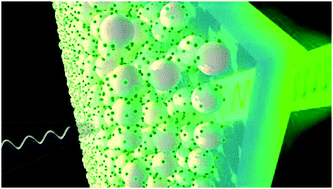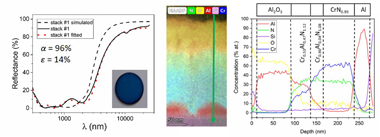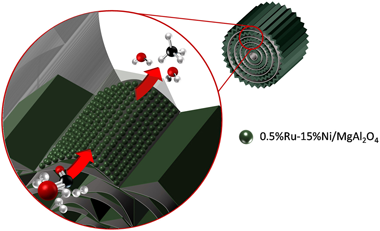Scientific Papers in SCI
2020
2020
Nanotecnología en Superficies y Plasma
Thin film electroluminescent device based on magnetron sputtered Tb doped ZnGa2O4 layers
Gil-Rostra, J; Valencia, FY; Gonzalez-Elipe, ARJournal of Luminescence, 228 (2020) 117617
Show abstract ▽
Photoluminescent (PL) layers and electroluminescent (EL) systems prepared by different methods have been systematically studied for the fabrication of flat panel displays, monitoring screens, and lighting systems. In this work we report about a new procedure of preparing Tb doped ZnGa2O4 green luminescent thin films at low temperature that consists of the simultaneous reactive magnetron sputtering (R-MS) deposition of a Zn-Ga mixed oxide acting as a matrix and the plasma decomposition (PD) of evaporated terbium acetylacetonate. The resulting films were transparent and presented a high PL efficiency making them good candidates for EL applications. Layers of this phosphor film with thickness in the order of hundreds nanometers were sandwiched between two dielectric layers of Y2O3 and AlSiNxOy that were also prepared by R-MS. The response of the resulting EL device was characterized as a function of the applied voltage and the type of AC excitation signal. The high luminance and long-term stability of these thin film electroluminescent devices (TFELDs) proves the reliability and efficiency of this kind of transparent R-MS multilayer system (with a total thickness in order of 650 nm) for display and lighting applications.
December, 2020 | DOI: 10.1016/j.jlumin.2020.117617
Materiales Ópticos Multifuncionales
Efficient third harmonic generation from FAPbBr(3) perovskite nanocrystals
Rubino, A; Huq, T; Dranczewski, J; Lozano, G; Calvo, ME; Vezzoli, S; Miguez, H; Sapienza, RJournal of Materials Chemistry C, 8 (2020) 15990-15995
Show abstract ▽

The development of versatile nanostructured materials with enhanced nonlinear optical properties is relevant for integrated and energy efficient photonics. In this work, we report third harmonic generation from organic lead halide perovskite nanocrystals, and more specifically from formamidinium lead bromide nanocrystals, ncFAPbBr(3), dispersed in an optically transparent silica film. Efficient third order conversion is attained for excitation in a wide spectral range in the near infrared (1425 nm to 1650 nm). The maximum absolute value of the modulus of the third order nonlinear susceptibility of ncFAPbBr(3), chi((3)NC), is derived from modelling both the linear and nonlinear behaviour of the film and is found to be chi((3)NC) = 1.46 x 10(-19) m(2) V-2 (or 1.04 x 10(-11) esu) at 1560 nm excitation wavelength, which is of the same order as the highest previously reported for purely inorganic lead halide perovskite nanocrystals (3.78 x 10(-11) esu for ncCsPbBr(3)). Comparison with the experimentally determined optical constants demonstrates that maximum nonlinear conversion is attained at the excitonic resonance of the perovskite nanocrystals where the electron density of states is largest. The ease of synthesis, the robustness and the stability provided by the matrix make this material platform attractive for integrated nonlinear devices.
December, 2020 | DOI: 10.1039/d0tc04790b
Tribología y Protección de Superficies
High-temperature solar-selective coatings based on Cr(Al)N. Part 2: Design, spectral properties and thermal stability of multilayer stacks
Rojas, TC; Caro, A; Escobar-Galindo, R; Sanchez-Lopez, JCSolar Energy Materials and Solar Cells, 218 (2020) 110812
Show abstract ▽

Two multilayer solar selective absorber coatings [Al/CrN0.95/Cr0.96Al0.04N1.08/Cr0.53Al0.47N1.12/Al2O3 (stack #1) and Cr0.96Al0.04N0.89/Cr0.62Al0.38N1.00/Cr0.53Al0.47N1.12/Al2O3 (stack #2)] were deposited on 316L steel by combining direct current (DC) and high power impulse magnetron sputtering (HiPIMS) technologies with the aim of increasing the working limit temperature. The composition and thickness of the constituent layers were optimized using CODE software to achieve a high solar absorptance (alpha) and low values of thermal emittance (epsilon) in the infrared region. The deposited multilayered stacks were heated during 2 h in air at 600, 700 and 800 degrees C to study their thermal stability and optical performance. Compositional, structural and optical characterization of the stacks (as-prepared and after thermal treatment) was performed. Both stacks presented a good solar selectivity with alpha > 95% and epsilon < 15%, were stable up to 600 degrees C and fulfilled the performance criterion PC < 5% after 600 and 700 degrees C treatments. Despite the stacks suffered chemical transformations above 600 degrees C, partial oxidation (stack #1) and Cr2N formation (stack #1 and #2), the optical properties were optimum up to 700 degrees C for stack #1 (alpha = 94%, epsilon((25 degrees C)) = 12%) and 600 degrees C for stack #2 (alpha = 93%, epsilon((25 degrees C)) = 13%). The solar-to-mechanical energy conversion efficiencies (eta) of the as-deposited and annealed (600 and 700 degrees C) samples were up to 20% points higher than the absorber paint commercially used (Pyromark). At 800 degrees C, they underwent a further structural transformation, provoked by the oxidation of the inner layers, and they consequently lost their solar selectivity.
December, 2020 | DOI: 10.1016/j.solmat.2020.110812
Química de Superficies y Catálisis
Ru-Ni/MgAl2O4 structured catalyst for CO2 methanation
Navarro, Juan C.; Centeno, Miguel A.; Laguna, Oscar H.; Odriozola, Jose A.Renewabel Energy, 161 (2020) 120-132
Show abstract ▽

Novel catalytic systems should be tested for the valorization of CO2 through the Sabatier reaction, since this process is gaining great importance within strategic sectors of the chemical industry. Therefore, this work explores the feasibility of structuring a catalyst (0.5%Ru-15%Ni/MgAl2O4) for CO2 methanation using metal micromonoliths. The coating of the catalyst over the surface of the micromonoliths is carried out by means of the washcoating procedure and different characterization techniques are applied to establish possible changes in the catalyst during structuring.
Regarding the performance in the Sabatier reaction, the structured systems are tested as well as the powder catalyst in order to establish the possible effects of the structuring processes. For this, variables such as catalyst loading, space velocity, inclusion of water in the feed-stream and the pressurization of the process were studied.
In general, the structuring of the proposed catalyst by the reported procedure is absolutely feasible. There are no substantial changes in the main features of the catalyst and this means that its catalytic performance is not altered after the structuring process either. Furthermore, the structured system exhibits high stability in a long-term test and is comparable with other CO2 methanation catalysts reported in research to date.
December, 2020 | DOI: 10.1016/j.renene.2020.07.055
Tribología y Protección de Superficies
Tailoring CrNx stoichiometry and functionality by means of reactive HiPIMS
Sanchez-Lopez, JC; Caro, A; Alcala, G; Rojas, TCSurface & Coatings Technology, 401 (2020) 126235
Show abstract ▽
This work presents a complete study of the influence of HiPIMS pulse characteristics on the microstructure, chemical composition, mechanical and oxidation resistance properties of CrN thin films. The investigated parameters were frequency and pulse length at two different nitrogen fluxes, maintaining constant the duty cycle conditions (2%). The effect of a negative bias of 100 V was investigated in a particular case. By changing the synthesis conditions, it was possible to tailor the N/Cr ratio and thus to control the CrNx stoichiometry from x = 0.63 to 1.10. The selection of longer pulses (shorter frequencies) generates more disordered structures with lower N/Cr ratios. This is reflected in higher hardness and elastic modulus values on despite of a lower oxidation resistance due to existence of larger concentration of N vacancies. The best oxidation resistance is obtained at the highest peak current combined with additional ion bombardment provided by substrate biasing. The present results open the possibilities of modifying chemical composition and engineering surfaces by changing exclusively the pulse conditions in HiPIMS deposition processes.
November, 2020 | DOI: 10.1016/j.surfcoat.2020.126235
- ‹ previous
- 90 of 410
- next ›














